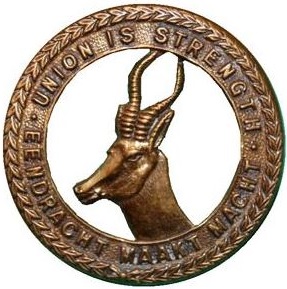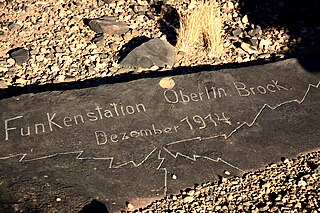
The South West Africa campaign was the conquest and occupation of German South West Africa by forces from the Union of South Africa acting on behalf of the British imperial government at the beginning of the First World War.

The German colonial empire constituted the overseas colonies, dependencies, and territories of the German Empire. Unified in 1871, the chancellor of this time period was Otto von Bismarck. Short-lived attempts at colonization by individual German states had occurred in preceding centuries, but Bismarck resisted pressure to construct a colonial empire until the Scramble for Africa in 1884. Claiming much of the remaining uncolonized areas of Africa, Germany built the third-largest colonial empire at the time, after the British and French. The German colonial empire encompassed parts of several African countries, including parts of present-day Burundi, Rwanda, Tanzania, Namibia, Cameroon, Gabon, Congo, Central African Republic, Chad, Nigeria, Togo, Ghana, as well as northeastern New Guinea, Samoa and numerous Micronesian islands.

The African theatre of the First World War comprises campaigns in North Africa instigated by the German and Ottoman empires, local rebellions against European colonial rule and Allied campaigns against the German colonies of Kamerun, Togoland, German South West Africa, and German East Africa. The campaigns were fought by German Schutztruppe, local resistance movements and forces of the British Empire, France, Italy, Belgium, and Portugal.

The South African Overseas Expeditionary Force (SAOEF) was a volunteer military organisation in World War I.

Theodor Gotthilf Leutwein was a German military officer and colonial administrator who served as Landeshauptmann and governor of German Southwest Africa from 1894 to 1905.
Naulila is a town and commune in the municipality of Ombadja, province of Cunene, Angola.
This is the history of South Africa from 1910 to 1948.
The Battle of Otavi fought between the militaries of the Union of South Africa and German Southwest Africa on 1 July 1915 was the final battle of the South West Africa Campaign of World War I. The battle, fought between Otavi mountain and Otavifontein, was a delaying action led by the German Major Hermann Ritter. Ritter's forces intended to buy the main German force at Tsombe several days so as they could harden their positions there. In the end, Botha's forces were able to rout Ritter's troops, leading to an overall breakdown in the German lines that brought the campaign to an end.

The Battle of Trekkopjes on 26 April 1915 was a German assault on the South African held railway station of Trekkopjes during the South West Africa Campaign of World War I. The South African Major Skinner had been ordered to defend Trekkopjes, and came into contact with a German column advancing on the station. Skinner withdrew back into Trekkopjes and dug in his forces. The German attack was repulsed with the help of armoured cars, leaving the South Africans victorious. The Battle of Trekkopjes saw the last German offensive in German South West Africa leaving them on the defensive for the remainder of the campaign.

German South West Africa was a colony of the German Empire from 1884 until 1915, though Germany did not officially recognise its loss of this territory until the 1919 Treaty of Versailles.

German South West Africa was a German colony in Africa, established in 1884 with the protection of the area around Lüderitz and abandoned during World War I, when the area was taken over by the British.
The battle of Kakamas took place in Kakamas, Northern Cape Province of South Africa on 4 February 1915. It was a skirmish for control of two river fords over the Orange River between contingents of a German invasion force and South African armed forces. The South Africans succeed in preventing the Germans gaining control of the fords and crossing the river.

The German campaign in Angola took place before the official declaration of war between Germany and Portugal in March 1916. German and Portuguese troops clashed several times on the border between German South West Africa and Portuguese Angola. The Germans won most of these clashes and were able to occupy the Humbe region of southern Angola until Portuguese control was restored a few days before the British campaign out of South Africa defeated the Germans.

Franz Heinrich Kleinschmidt (1812–1864) was a German missionary and linguist who worked in southern Africa, now in the region of Namibia. He founded the missionary station and town of Rehoboth and together with Carl Hugo Hahn set up the first Rhenish mission station to the Herero people in Gross Barmen. Kleinschmidt is known for his scientific work on the Nama language.

The history of rail transport in Namibia began with a small mining rail line at Cape Cross in 1895. The first major railway project was started in 1897 when the German Colonial Authority built the 600 mm gauge Staatsbahn from Swakopmund to Windhoek. By 1902 the line was completed.

Namibia is a multilingual country in which German is recognised as a national language. While English has been the sole official language of the country since 1990, in many areas of the country, German enjoys official status at a community level. A national variety of German is also known as Namdeutsch.
Utuseb is a small settlement in the Erongo Region in western central Namibia. It is situated in the Namib Desert, approximately 40 kilometres (25 mi) from Walvis Bay on the banks of Kuiseb River. Utuseb has approximately 700 inhabitants and belongs to the Walvis Bay Rural electoral constituency. The people living here belong to the ǂAonin community, a subtribe of the Nama people.
The Topnaar people (ǂAonin) are a clan of the Nama people in Namibia. Their settlements are all situated on the Kuiseb River in the Erongo Region of central Namibia, the largest one is Utuseb.

The Imperial Schutztruppe for German South West Africa was the official name of the military formation that maintained the German Empire in its colony of German South West Africa. The Schutztruppe are held responsible for numerous atrocities in the Herero and Nama uprising in 1904. During the First World War, the Schutztruppe was defeated by the troops of the Union of South Africa.

A series of radio stations in German South West Africa enabled the Germans to communicate between their colony, German South West Africa, and their motherland, the German Empire. They also used radio to communicate within the German South West Africa territory and with German boats at sea. The stations utilized spark-gap transmitters.















